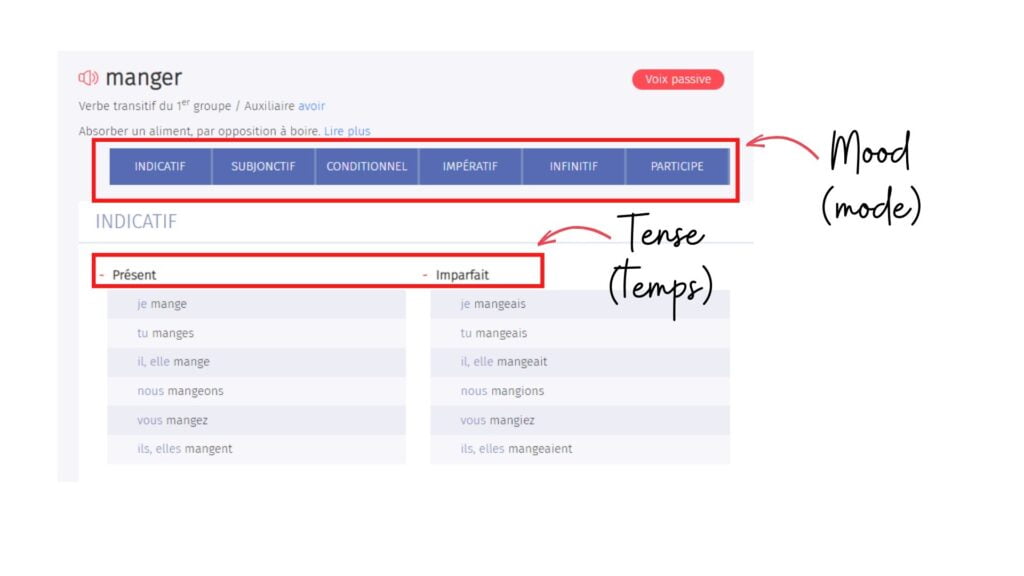Bonjour tout le monde ! Today, I will guide you through one the questions that have been coming back to me as a French teacher : when and how to use passé composé VS imparfait ?
Quand je suis allée chez ma mère, j’ai mangé une salade et elle était délicieuse !
Many French learners struggle when it comes to the use of passé composé VS imparfait. You probably know that they are both past tenses in French, but how do we use them ? Say no more, let’s jump into this lesson right away !
Passé composé VS Imparfait : Listen To The Podcast
Passé composé VS Imparfait

Passé composé and imparfait are the two tenses that you are going to use when you want to express something that happened in the past.
Quand je suis allée chez ma mère, j’ai mangé une salade et elle était délicieuse !
When I went at my mother’s, I ate a salad and it was delicious!
In that sentence, we have :
Passé composé : je suis allée (I went), j’ai mangé (I ate).
Imparfait: elle était (it was).
As you might have noticed already, passé composé is composed of 2 elements : the auxiliary verb + past participle of a verb.
Imparfait is another simple tense.
Le passé composé
Le passé composé (composed past) is a composed tense. It is used to express a finished action in the past.
J’ai mangé une salade / Je suis allée au supermarché.
How it is formed
We form passé composé using the auxiliary verb être or avoir conjugated at the present tense :
Être
Je suis
Tu es
Il / Elle / On est
Nous sommes
Vous êtes
Ils / Elles sont
Avoir
J’ai
Tu as
Il / Elle / On a
Nous avons
Vous avez
Ils / Elles ont
The past participle (le participe passé)
To form the past participle in French, you will need to take the stem of the verb and add the following endings:
1st and 2nd group verbs
| 1st group verbs (-er) | 2nd group verbs (-ir) |
Masculin | -é | -i |
Féminin | -ée | -ie |
Masculin pluriel | -és | -is |
Féminin pluriel | -ées | -ies |
For example :
Manger : mangé / mangée / mangés / mangées
Finir : fini / finie / finis / finies
3rd group verbs
Verbe | Participe passé | Verbe | Participe passé |
Prendre | Pris(e)(s) | Suivre | Suivi(e)(s) |
Courir | Couru(e)(s) | Venir | Venu(e)(s) |
Voir | Vu(e)(s) | Savoir | Su(e)(s) |
Vouloir | Voulu(e)(s) | Être | Été |
Croire | Cru(e)(s) | Avoir | Eu(e)(s) |
If you are looking for the past participle of a particular verb, I would strongly advise you to use one of the best tools for learning French that I use myself : Le Conjugueur. You’ll be able to type in any verb and scroll down all the way to “Participe Passé”.
Être or Avoir ?
L’imparfait
L’imparfait is a simple tense (temps simple), that you should use to express yourself in past tense.
How it is formed
To form l’imparfait, this is the pattern that you should follow :
Step 1 : Conjugate the verb at the present tense, using the personal pronoun “nous”.
Step 2 : Remove the “-ons”. You are left with the stem.
Step 3 : add the following endings ;
Pronoun | Ending |
Je | – ais |
Tu | – ais |
Il / Elle / On | – ait |
Nous | – ions |
Vous | – iez |
Ils / Elles | – aient |
For example, let’s take the verb “Chanter“.
Step 1 : Nous chantons.
Step 2 : The stem is “CHANT-“.
Step 3 : Conjugation.
Pronoun | Verb |
Je | chantais |
Tu | chantais |
Il / Elle / On | chantait |
Nous | chantions |
Vous | chantiez |
Ils / Elles | chantaient |
You might also like:
When to use passé composé vs imparfait
Here’s what you need to know.
It is used to express actions that are finished, in the past.
Imparfait :
– to talk about habits in the past : Je me levais à 6h. (I used to wake up at 6 AM)
– descriptions and state in the past tense : La maison était silencieuse. Mais j’avais l’impression qu’elle était habitée. (The house was silent. But I was under the impression that it was inhabited)
– to express an ongoing action in the past (past progressive) : Il me racontait ses vacances quand sa mère l’a appelé. (He was talking to me about his holidays when his mother called him)
So I would like you to picture this in your mind. Think of a play at the theater (or a film). The decor and the setting would be l’imparfait and the actors performing would be the passé composé. That’s how I like to explain it to my students when they struggle with passé composé vs imparfait.
Passé composé vs Imparfait : Conclusion









Thank you so much. It was very clear n useful.
Merci beaucoup !
Thank you !
It is very helpful
Thank you for your feedback! I’m glad you enjoyed 🙂